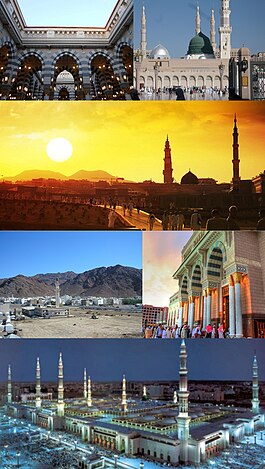Medina
Medina (/məˈdiːnə/; Arabic: المدينة المنورة, al-Madīnah al-Munawwarah , "the radiant city"; or المدينة, al-Madīnah (Hejazi pronunciation: [almaˈdiːna]), "the city"), also transliterated as Madīnah, is a city in the Hejaz, and the capital of the Al Madinah Region of Saudi Arabia. The city contains al-Masjid al-Nabawi ("the Prophet's Mosque"), which is the burial place of the Islamic prophet Muhammad, and is the second-holiest city in Islam after Mecca.
Medina
المدينة المنورة | |
|---|---|
 Medina montage | |
Medina in Saudi Arabia | |
| Coordinates: 24°28′12″N 39°36′36″E / 24.47000°N 39.61000°E | |
| Country | |
| Province | Medina |
| Government | |
| • Mayor | Fahad Al-Belaihshi |
| Area | |
| • Total | 589 km2 (227 sq mi) |
| Population (April 28, 2010) | |
| • Total | 1,100,093 |
| • Density | 1,868/km2 (4,840/sq mi) |
| Time zone | UTC+03:00 (SAST) |
| Area code | 109223 |
| Website | Official website |
Medina was Muhammad's destination after his Hijrah from Mecca, and became the capital of a rapidly increasing Muslim Empire, first under Muhammad's leadership, and then under the first four Rashidun caliphs, Abu Bakr, Umar, Uthman, and Ali. It served as the power base of Islam in its first century where the early Muslim community developed. Medina is home to the three oldest mosques, namely the Quba Mosque, al-Masjid an-Nabawi,[1] and Masjid al-Qiblatayn ("the mosque of the two qiblas"). Muslims believe that the chronologically final surahs of the Quran were revealed to Muhammad in Medina, and are called Medinan surahs in contrast to the earlier Meccan surahs.[2][3]
Similar to Mecca, non-Muslims are forbidden from entering the sacred core of Medina or the center of the city.[4][5][6]
Overview change
Medina currently has a population of more than 1,300,000 people (2006). The city was originally known as Yathrib, but later its name was changed to Madīnat al-Nabī (مدينة ﺍﻟﻨﺒﻲ IPA: [mæˈdiːnæt æˈnːæbiː] "city of the prophet") or Al Madīnah al Munawwarah ("the enlightened city" or "the radiant city"). The short form Madīnah simply means "city". Madina is the second holiest city of Islam, after Mecca (Makkah).[7]
Medina's religious significance in Islam change
Medina is the second holiest site in Islam after Mecca that's why Medina is very important to Muslims.[8] This is because Prophet Muhammad is buried in a mosque known as 'Masjid-e-Nabawi' or 'The Mosque of The Prophet' located in Medina. The Mosque was built on a site next to Muhammad's home. Muslims believe [source?] that Prophets must be buried at the very same place that they die. Accordingly, Muhammad was buried in his house. The tomb later became part of the mosque when it was expanded by the Umayyad Caliph Al-Walid I. The first mosque of Islam is also in Medina. It is known as Masjid Quba, (the Quba Mosque).
Like Mecca, the city of Medina only permits Muslims to enter. The haram (area closed to non-Muslims) of Medina is much smaller than that of Mecca, though. Many facilities on the outskirts of Medina are open to non-Muslims. In Mecca the area closed to non-Muslims extends well beyond the limits of the built-up area. Both cities' numerous mosques are the destination for large numbers of Muslims on their annual pilgrimage. Hundreds of thousands of Muslims come to Medina each year to visit the 'Tomb of Prophet' and to worship at mosques in a unified celebration. Muslims believe that praying once in the Mosque of the Prophet is equal to praying at least 1000 times in any other mosque.[9]
References change
- ↑ "Masjid Quba' – Hajj". Saudi Arabia: Hajinformation.com. Retrieved 26 March 2013.
- ↑ Khan, A.M. (2003). Historical Value Of The Qur An And The Hadith. Global Vision Publishing House. p. 26. ISBN 978-81-87746-47-8.
- ↑ Al-Laithy, Ahmed (2005). What Everyone Should Know about the Qurʼan. Garant. p. 61. ISBN 978-90-441-1774-5.
- ↑ Esposito, John L. (2011). What everyone needs to know about Islam. Oxford University Press. p. 25. ISBN 978-0-19-979413-3.
Mecca, like Medina, is closed to non-Muslims
- ↑ Sandra Mackey's account of her attempt to enter Mecca in Mackey, Sandra (1987). The Saudis: Inside the Desert Kingdom. W. W. Norton & Company. pp. 63–64. ISBN 978-0-393-32417-4.
- ↑ Cuddihy, Kathy (2001). An A To Z Of Places And Things Saudi. Stacey International. p. 148. ISBN 978-1-900988-40-7.
- ↑ However, an article in Aramco World[permanent dead link] by John Anthony states: "To the perhaps parochial Muslims of North Africa in fact the sanctity of Kairouan is second only to Mecca among all cities of the world." Saudi Aramco’s bimonthly magazine's goal is to broaden knowledge of the cultures, history and geography of the Arab and Muslim worlds and their connections with the West; pages 30-36 of the January/February 1967 print edition [1] Archived 2004-06-24 at the Wayback Machine
- ↑ Abdullah (6 July 2016). "The Prophet's Mosque: An insight into Islam's second-holiest site". al arabiya.
- ↑ Abdul, Latef (25 April 2013). "The rewards of praying at the 3 Sacred Mosque". Word Press. Retrieved 16 October 2023.
Other websites change
- Beautiful Masajids Of Madina Munawara, Details And Pictures Archived 2007-12-27 at the Wayback Machine (in Urdu)
- Satellite map of Medina - Google
- Pictures of Medina Munawwara Archived 2007-12-16 at the Wayback Machine
- Medina's religious significance in Islam Archived 2022-04-24 at the Wayback Machine
